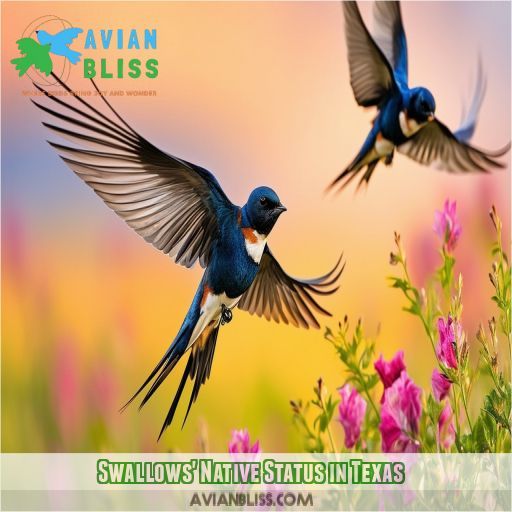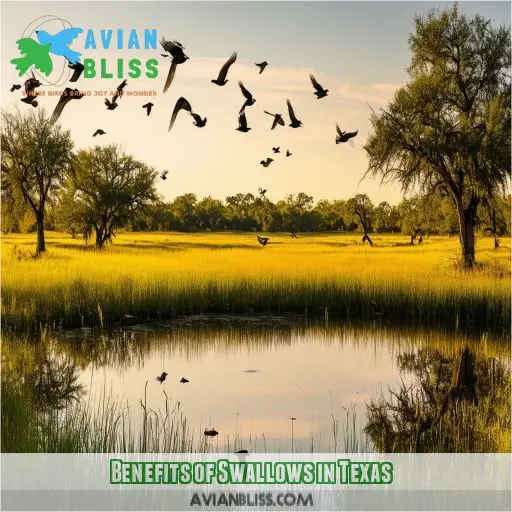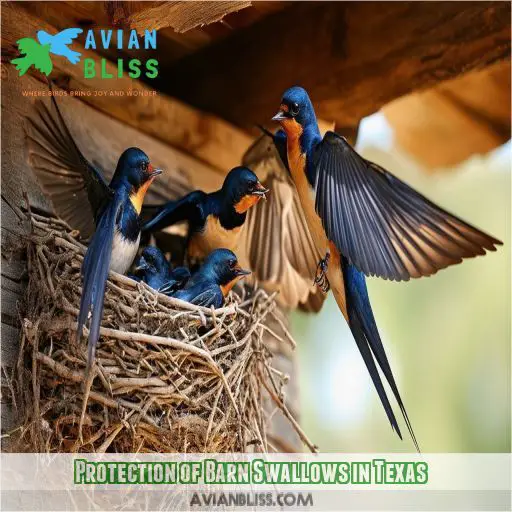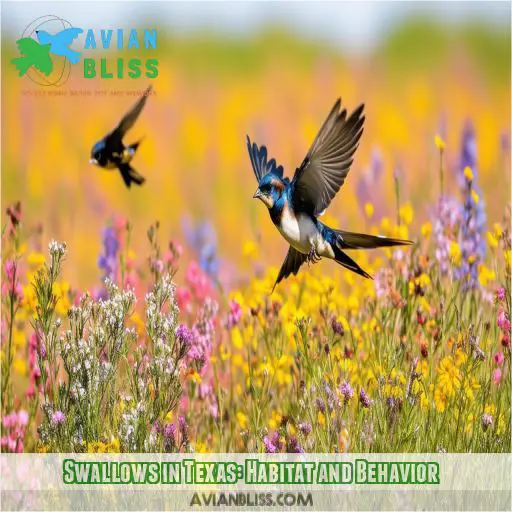This site is supported by our readers. We may earn a commission, at no cost to you, if you purchase through links.

With acrobatic aerial displays that involve the intake of insects, they inadvertently serve agriculture and the urban landscape. Their nests, however, are protected by statutory provisions, and thus coexistence with man becomes necessary.
Appreciation of swallows in Texas is associated with their ecological, socio-economic, and legal significance in conserving these crucial birds and the balance of nature they retain.
Table Of Contents
- Key Takeaways
- Swallows’ Native Status in Texas
- Ecological Role of Swallows in Texas
- Benefits of Swallows in Texas
- Nest Removal Regulations in Texas
- Protection of Barn Swallows in Texas
- Swallows in Texas: Habitat and Behavior
- Legal Status of Swallow Species in Texas
- Human-Swallow Conflict Resolution in Texas
- Frequently Asked Questions (FAQs)
- Can you remove a swallows nest in Texas?
- Are swallows native to Texas?
- Are swallows good to have around?
- Why are barn swallows protected in Texas?
- How many species of swallows live in Texas?
- What do swallows eat in Texas?
- When do barn swallows arrive in Texas?
- Why are barn swallows protected?
- How do swallows affect mosquito populations?
- Conclusion
Key Takeaways
- Swallows: Texas’s Unsung Heroes – These feathered friends gobble up tons of insects, keeping your backyard and the great outdoors pest-free.
- Nature’s Health Check – Swallow populations are a mirror into the well-being of our environment. Their presence, habits, and numbers tell us how our ecosystem is faring.
- Legal Protectors of the Skies – Texas law has got your back, swallows! Their nests are off-limits during breeding season.
- Harmony with Nature – Finding ways to coexist with swallows is a win-win. Relocating nests, providing alternatives, and educating others helps these birds thrive alongside us.
Swallows’ Native Status in Texas
Of the swallows, all very adaptable and hardy birds, all are native to Texas and have flourished almost throughout. Their breeding habits are rather interesting; males usually arrive sometime before females to establish territories with quite an impressive aerial display. Most prefer making nests on artificial structures like highway culverts, bridges, and buildings because of their open approach and the constant availability of materials.
Since the 1960s, road premises have highly contributed to increased swallow populations in Texas for decades. Their close association with such infrastructure has led to their wide distribution today. Swallows, on the other hand, are acknowledged as part of the Migratory Bird Treaty Act and thus come under protection; therefore, it’s illegal to destroy their active nests. Acquaintance with where to find swallows and respecting their places of nests is perfect for conservancy. Such dynamic population dynamics, coupled with historical trends, portray the ecological value that these birds create within Texas’s vast landscape.
Ecological Role of Swallows in Texas
Swallows are essential components of Texas’ ecosystems. A few insectivorous birds have what’s considered an essential ecological function: keeping an optimum population of insects to maintain environmental homeostasis. It’s through their reluctance to feed on enormous quantities of insects that swallows presumably reduce pest pressure on crops and lower the transmission of disease by limiting the number of possible vectors. Each species, from the Barn Swallow to the Cave Swallow, has its peculiarities about foraging habits and diet preferences with specific impacts on different communities of insects.
Swallow habitat trends indicate a reliance upon artificial structures such as bridges and culverts, thus following the species’ adaptability and, therefore, the importance of conservation efforts. The swallows’ migration pattern brings them back to Texas each breeding season, and enhances local biodiversity. You’ll generally see a mixture of swallow species together in areas with food aplenty, which further explains their role in the ecosystem. Knowing swallow population dynamics enables appropriate conservation practices to ensure swallows continue to thrive and support the natural environment of Texas.
Benefits of Swallows in Texas
Swallows in Texas provide key benefits, including natural pest control by consuming vast amounts of insects, which helps keep mosquito populations in check. Additionally, their presence serves as an indicator of ecosystem health and fosters enriching human-wildlife interactions, making your environment more vibrant and engaging.
Natural Pest Control
Swallows in Texas act as natural pest control agents by consuming vast quantities of flying insects daily. Their diet includes mosquitoes, wasps, and flies, which they foraging efficiently in their habitats. This helps maintain a balanced ecosystem, reduces human-wildlife conflicts, and supports swallow population conservation.
Ecosystem Health Indicator
Swallows serve as excellent ecosystem health indicators. Their presence, abundance, and behavior reflect environmental conditions. Adaptations like aerial insect hunting, migration patterns, and nesting habits signal ecosystem changes. Monitoring species like the Barn Swallow and Purple Martin helps scientists gauge biodiversity and ecosystem sustainability, informing conservation efforts.
Human-Wildlife Interaction
Swallows, with their acrobatic movements, showcase an incredible human-wildlife interaction. Their feeding behavior benefits daily life, reducing insect populations. Enjoy observing their species diversity. Whether marveling at cliff swallows or admiring barn swallows’ nesting sites, these birds foster a unique coexistence. Consider:
- Nuisance control
- Breeding success
- Nature’s beauty
Nest Removal Regulations in Texas
As far as the removal of nests is concerned across the state of Texas, there are critical considerations concerning the legal stature of swallows and the conservation measures involved. You can’t just remove nests of the Barn Swallow, Tree Swallow, Bank Swallow, Cliff Swallow, or Cave Swallow without permission. Each of these birds is protected under the Migratory Bird Treaty Act, which forbids the disturbance of active nests.
You wouldn’t want to consider any action before ensuring that the nest is active, containing eggs or chicks. If removing a nest is necessary, it’s essential to contact wildlife authorities in your area to make sure you aren’t in violation of rules and regulations and supporting trends in population growth. Indeed, restoring habitat will provide other areas for nesting sites, hence reducing the conflict. Respect for swallows’ life cycle protects them and upholds their role in their ecosystems. Remember, each bird plays a vital role in preserving this balance of nature.
Protection of Barn Swallows in Texas
Being a Texan, you can contribute to ensuring that these endearing Barn Swallows in your town are protected. You may want to use swallow nesting boxes around your property to protect these beautiful birds.
In addition to establishing positive associations between humans and swallows, you might be able to act along with their conservation. Engage in habitat restoration projects like native vegetation planting to create welcoming environments that will entice swallows and many other wildlife species.
Educational-level awareness programs can further underscore the need for swallows as a part of the ecosystem. Not as well-known are the Violet-green Swallow and Northern Rough-winged Swallow; protection is just as crucial for these as the others. You’ll further maintain the well-being and balance of Texas’ great natural features in accepting swallows and their role within the state.
Swallows in Texas: Habitat and Behavior
As you explore the diverse world of swallows in Texas, you’ll be captivated by their unique habitats and fascinating behaviors. These aerial acrobats thrive in a variety of environments, from open fields and marshes to urban areas and rural farmlands. Keep an eye out for their intricate mud nests, often tucked under bridges, eaves, or in the crevices of buildings. Listen closely, and you may even hear their melodic trills and chatters as they communicate with one another.
- Swallows are known for their impressive migratory patterns, with some species traveling thousands of miles between their breeding and wintering grounds.
- Identifying different swallow species can be a rewarding challenge, as each has its own distinctive plumage and field marks.
- Swallow populations in Texas have shown promising trends in recent years, thanks to conservation efforts and the abundance of suitable nesting sites.
- Understanding swallow behavior and habitat preferences can help us coexist harmoniously with these remarkable birds.
Legal Status of Swallow Species in Texas
In relating the legal status of swallow species to that in Texas, what one looks at is driven by legality and conservation means. Swallows, specifically Barn Swallow, are covered under the federal protection of the Migratory Bird Treaty Act. According to this act, federal GOP infringement forbids capturing, killing, unsettling these birds, or even damaging their nests.
Habitat preservation is essential in their protection so that they can breed and forage efficiently. Sadly, conflicts with the law commonly arise because human establishments encroach on their habitats. Enforcement measures include strict rules about removing or altering nests during breeding seasons. Planning and complying with these laws is paramount for their conversation. In this way, we can contribute to the preservation of Texas’ swallow populations as an integral part of the ecosystem through preserved natural habitats and compliance with preservative legislation.
Human-Swallow Conflict Resolution in Texas
Resolving some conflicts with swallows requires understanding their behavior, communication, and many other factors. It’s easy for swallows to express agitation, especially toward humans who get close to their nests. If Swallows nest in troublesome sites: Consider relocating nests. It is, however essential that individuals know that active nests can’t be disturbed legally.
If the risk of conflict can’t be avoided, provide alternative nesting sites nearby. Birdhouses or patches of mud will help the swallows seek a new home without moving too far away from their lodging and dwelling place. The eating habits benefit pest control, but droppings can become quite a nuisance; eaves or netting will reduce this problem.
But at all costs, avoid direct contact with them, even though there’s hardly any chance of disease transmission. Notifying oneself and others about the roles held by these birds and their needs dramatically eases co-existence and ensures that swallows continue benefiting the ecosystem here in Texas.
Frequently Asked Questions (FAQs)
Can you remove a swallows nest in Texas?
In Texas, you shouldn’t remove a swallows’ nest during the breeding season due to legal protections under the Migratory Bird Treaty Act. If necessary, wait until after the nesting period or consult wildlife authorities.
Are swallows native to Texas?
You’ll be amazed to know that swallows are native to Texas! These aerodynamic acrobats, which include species like Barn Swallows and Cave Swallows, thrive in various habitats and have adapted well to the Texan environment.
Are swallows good to have around?
Swallows are definitely good to have around. They consume large quantities of insects, including mosquitoes, helping control pests. Additionally, their communal behaviors and flight patterns offer enjoyment and enhance your connection to nature.
Why are barn swallows protected in Texas?
Barn swallows are protected in Texas due to their beneficial role in controlling insect populations, their reliance on human structures for nesting, and federal protections under the Migratory Bird Treaty Act, ensuring their conservation and ecological balance.
How many species of swallows live in Texas?
You’ll find eight swallow species in Texas: Barn, Bank, Cave, Cliff, Northern Rough-winged, Tree, Violet-green, and Purple Martin. They’re spread across diverse habitats, sharing their aerial acrobatics and insect-control benefits.
What do swallows eat in Texas?
Swallows in Texas primarily eat flying insects, including moths, flies, and beetles. You’ll often see them foraging in open areas, skimming over water surfaces, or catching prey mid-air with agile, acrobatic flight.
When do barn swallows arrive in Texas?
Barn swallows arrive in Texas as early as late March. The males come first to establish territories, with the breeding season stretching until mid-August, offering ample time for multiple clutches and intricate courtship displays.
Why are barn swallows protected?
It is protected because barn swallows are significant controllers of the insect population, mainly regarding mosquitoes. Their habits of nesting also reflect the health of an ecosystem, making them vital indicators for environmental stability and biodiversity.
How do swallows affect mosquito populations?
Through huge consumption of flying insects, swallows significantly reduce the populations of mosquitoes. In this way, they regulate these pests with their foraging behavior and enhance outdoor experiences, thus adding significantly to human comfort and public health.
Conclusion
Appreciating swallows in Texas means being aware of concerns about native status, ecological function, and values associated with natural pest control and ecosystem health indicators.
Knowing legal protection for nests and how to resolve human-swallow conflicts is essential. By appreciating their acrobatic flight display and placing them into your vision of a rural or urban landscape, you promote balanced ecosystems.
Knowledge of the legal status and swallows’ behavior in Texas underpins harmonious coexistence and, therefore ensures their conservation.











